Masaba people and their Culture in Uganda
Who are the Masaba People in Uganda? The Masaba, or Bamasaaba, are a Bantu people inhabiting the Eastern Ugandan districts of Sironko, Manafwa, Bududa,Mbale and Bulambuli
They are closely related to the Bukusu and Luhya of Western Kenya, they are a mainly agricultural people, farming millet, bananas and sorghum on small-holder plots.
Maize became popular with the coming of Europeans in late 1890s.
History of the Bamasaaba
The Bamasaaba are a Bantu people group of about 1,000,000 who live in eastern Uganda, Mbale and Sironko Districts, adjacent to Mt. Elgon at the Kenyan border.
They were the first people to inhabit the western and southwestern slopes of Mt. Elgon. The area is considered the food-basket of Uganda and is also known for producing high-quality Arabica coffee, the main cash crop.
The Bamasaaba are subsistence farmers, growing bananas, sweet and Irish potatoes, cabbage, tomatoes and onions. They also raise cattle and other livestock and trade on a small scale.
The main custom that distinguishes them from other tribes is their tradition of male circumcision. They see this rite as their defining feature as a tribe.
They also have different naming rituals and worship a different local god than their neighbors although the majority belongs to one of the many Christian churches in the area.
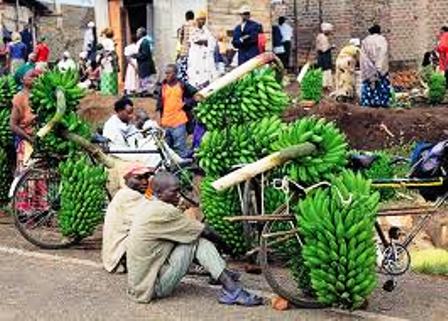 Matoke, the traditional food of the bamasaaba people in uganda
Matoke, the traditional food of the bamasaaba people in ugandaThe problem they face is the dense population and minimal land; a father's land is inherited by all of his sons, so the land is being divided further and further into very small plots.
The Bamasaaba are famous for their traditional male circumcision ceremonies, held every even year.
In a three-day ceremony of dancing and feasting, preceding a couple of months preparations, the initiates are admitted into adulthood and expected to begin their formal contribution to the growth of their respective communities.
The name Bamasaaba is sometimes used interchangeably with the name Bagisu, even though the latter is actually a tribe of the Bamasaaba nation.
The current Babukusu of western Kenya are believed to have migrated from the Bamasaaba, particularly from areas around Bubulo, in current Manafwa District.
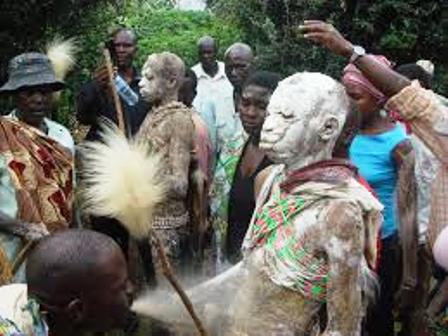 wasala embalu
wasala embaluMany clans among the Babukusu have their origins among the Bamasaaba, a testimony to this linkage. Masinde Muliro, once a veteran politician and elder of the Babukusu from Kitale, was from the Bakokho clan, with its base at Sirilwa, near Bumbo in Uganda.
Other clans common to both sides include Batiiru Babambo, Baata, Bakitang'a and Batiiru.
There are other clans whose names, however, that are only on one side, such as Babichache and Balonja who are mainly among the Babukusu. The common cultural ties are a further indication of close relations among the two sister ethnic groups.
During the Constituent Assembly that led to the 1995 Constitution of Uganda, Mulongo Simon, a Delegate from Bubulo East, introduced Babukusu as one of the ethnic groupings of Uganda, acknowledging the fact that both groups, Bamasaaba and Babukusu are intertwined.
The Bamasaaba and Politics.
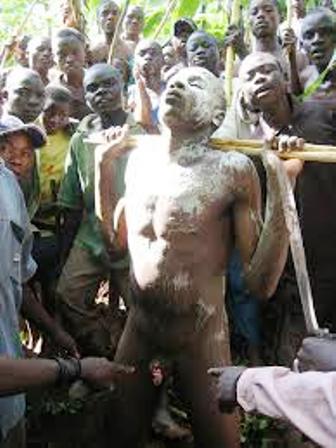 Tradtional Circumcision among the Bamasaba
Tradtional Circumcision among the BamasabaBefore the arrival of Europeans, Bamasaaba were organised in a decentralized way, but maintained strong clan system that brought them together as a community. They had a strong fighting force of youths, whose pre-occupation was to herd livestock and to train in warfare.
They warded off attackers from neighboring communities such as the Luo, Iteso, Elgon Masaai (Sabot and Sebei). Earlier, when the Maasai were still dominant in the eastern part of Mt. Elgon, they were the traditional hostile neighbours.
The dual economic activity of both crop and animal husbandry generated a resilient economy that supported their livelihoods and developed into an independent cultural community that endured centuries of hostility.
The advance of the European missionaries in late 1890s, facilitated by Kakungulu, a British Muganda agent, established a base for the British colonial rule in the area. This changed drastically the geo-political settings of the Bamasaaba form there onwards.
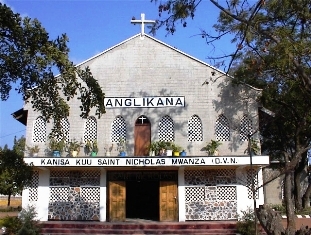
The Church Missionary Society (CMS)led by Bishop Tucker, assisted by Kakungulu, established British and particularly Anglican systems in the area. They built, through forced labour, road infrastructure and established administrative units.
By independence in 1962, Bamasaaba had had several western educated personalities with some schools, such as Nabumali High School, excelling in national examinations.
Mbale town was the cleanest in the country. Professors Timothy Wangusa, Bigala and later Dani Wadada Nabudere were among the leading academics from the Bamasaaba. George Masika, the Chief Justice and Masette Kuuya, a youthful minister during Obote II in 1980s, James Wambogo Wapakhabulo, the foreign Minister in the Museveni regime are examples of leading personalities from the Bamasaaba.
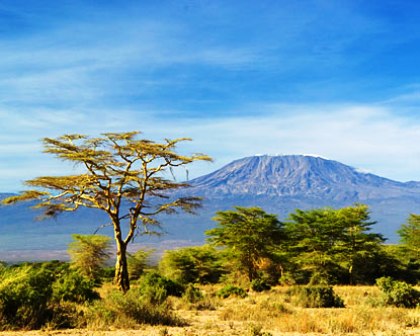
Other Pages of Interest
Kenya Cultural Origins |
Kenya Student Rules |
Kikuyu People |
Luo in Kenya |
Masai People |
Samburu People |
Student Class Rules |
Turkana People in Kenya |
Recent Articles
-
Garam Masala Appetizers ,How to Make Garam Masala,Kenya Cuisines
Sep 21, 14 03:38 PM
Garam Masala Appetizers are originally Indian food but of recent, many Kenyans use it. Therefore, on this site, we will guide you on how to make it easily. -
The Details of the Baruuli-Banyara People and their Culture in Uganda
Sep 03, 14 12:32 AM
The Baruuli-Banyala are a people of Central Uganda who generally live near the Nile River-Lake Kyoga basin. -
Guide to Nubi People and their Culture in Kenya and Uganda
Sep 03, 14 12:24 AM
The Nubians consist of seven non-Arab Muslim tribes which originated in the Nubia region, an area between Aswan in southern
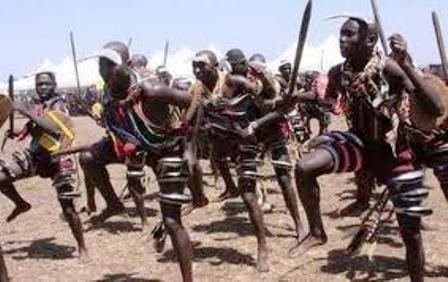







New! Comments
Have your say about what you just read! Leave me a comment in the box below.